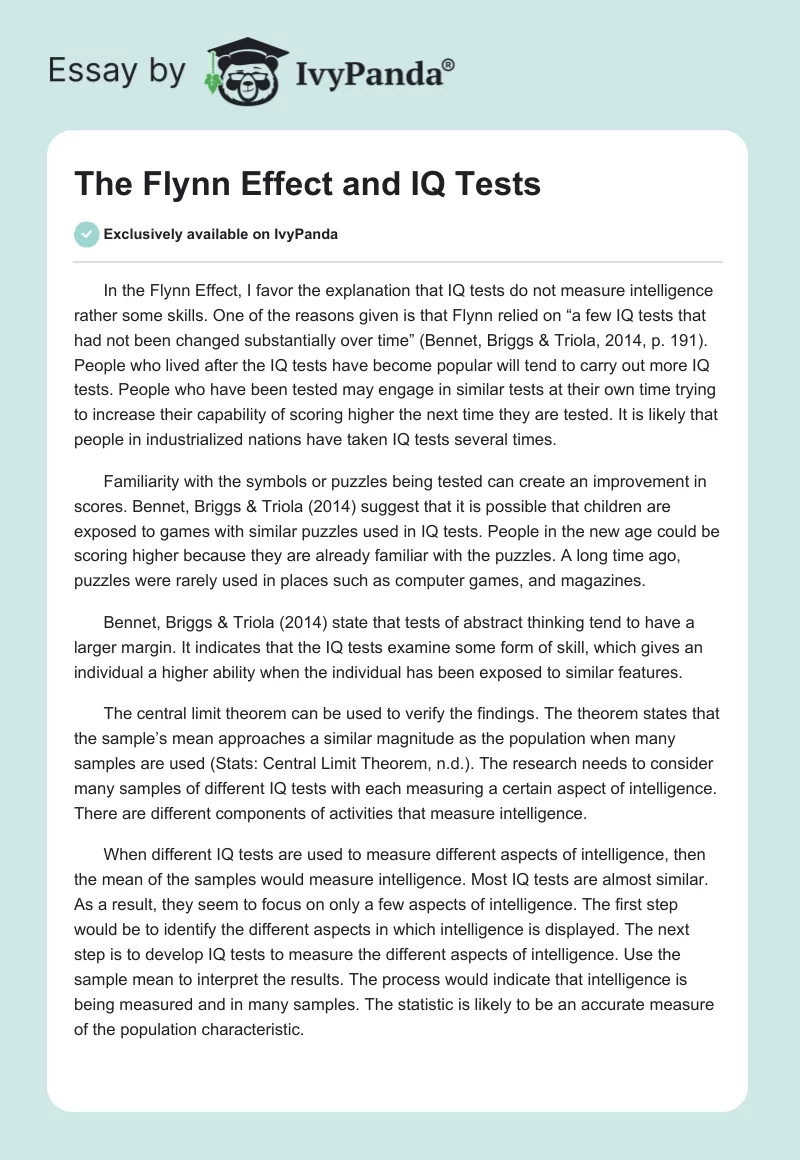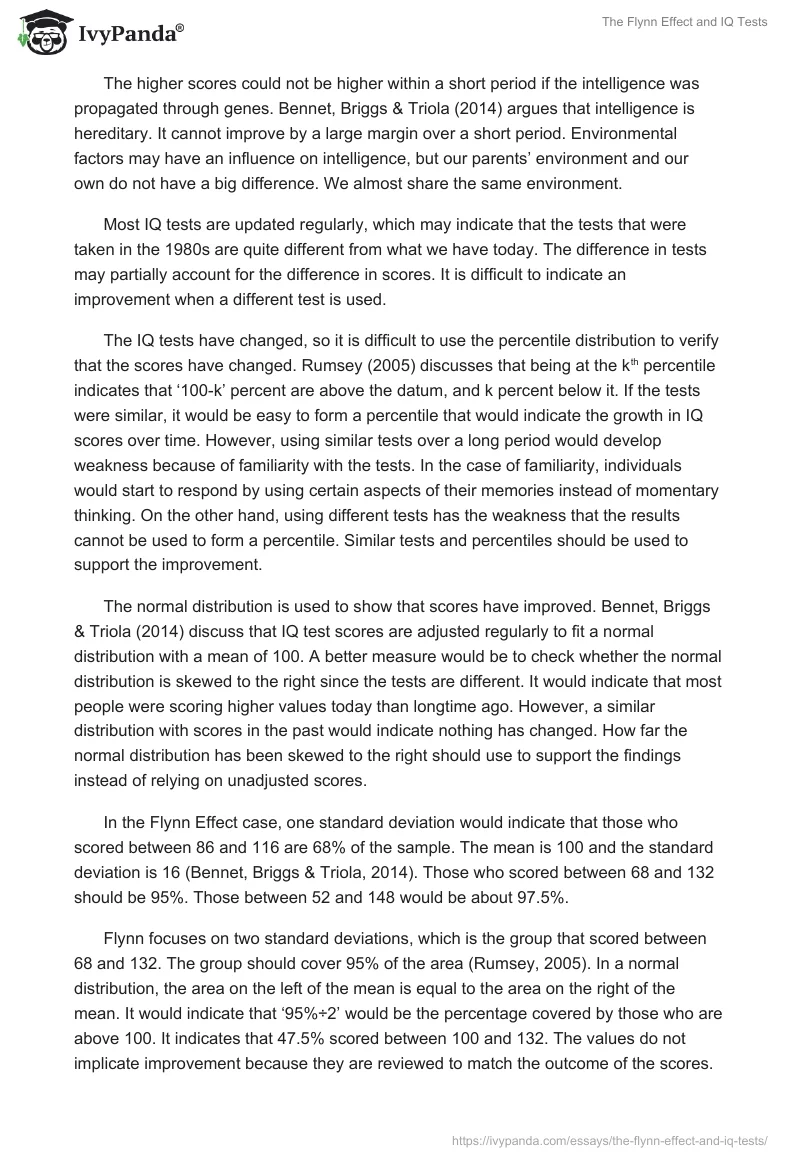In the Flynn Effect, I favor the explanation that IQ tests do not measure intelligence rather some skills. One of the reasons given is that Flynn relied on “a few IQ tests that had not been changed substantially over time” (Bennet, Briggs & Triola, 2014, p. 191). People who lived after the IQ tests have become popular will tend to carry out more IQ tests. People who have been tested may engage in similar tests at their own time trying to increase their capability of scoring higher the next time they are tested. It is likely that people in industrialized nations have taken IQ tests several times.
Familiarity with the symbols or puzzles being tested can create an improvement in scores. Bennet, Briggs & Triola (2014) suggest that it is possible that children are exposed to games with similar puzzles used in IQ tests. People in the new age could be scoring higher because they are already familiar with the puzzles. A long time ago, puzzles were rarely used in places such as computer games, and magazines.
Bennet, Briggs & Triola (2014) state that tests of abstract thinking tend to have a larger margin. It indicates that the IQ tests examine some form of skill, which gives an individual a higher ability when the individual has been exposed to similar features.
The central limit theorem can be used to verify the findings. The theorem states that the sample’s mean approaches a similar magnitude as the population when many samples are used (Stats: Central Limit Theorem, n.d.). The research needs to consider many samples of different IQ tests with each measuring a certain aspect of intelligence. There are different components of activities that measure intelligence.
When different IQ tests are used to measure different aspects of intelligence, then the mean of the samples would measure intelligence. Most IQ tests are almost similar. As a result, they seem to focus on only a few aspects of intelligence. The first step would be to identify the different aspects in which intelligence is displayed. The next step is to develop IQ tests to measure the different aspects of intelligence. Use the sample mean to interpret the results. The process would indicate that intelligence is being measured and in many samples. The statistic is likely to be an accurate measure of the population characteristic.
The higher scores could not be higher within a short period if the intelligence was propagated through genes. Bennet, Briggs & Triola (2014) argues that intelligence is hereditary. It cannot improve by a large margin over a short period. Environmental factors may have an influence on intelligence, but our parents’ environment and our own do not have a big difference. We almost share the same environment.
Most IQ tests are updated regularly, which may indicate that the tests that were taken in the 1980s are quite different from what we have today. The difference in tests may partially account for the difference in scores. It is difficult to indicate an improvement when a different test is used.
The IQ tests have changed, so it is difficult to use the percentile distribution to verify that the scores have changed. Rumsey (2005) discusses that being at the kth percentile indicates that ‘100-k’ percent are above the datum, and k percent below it. If the tests were similar, it would be easy to form a percentile that would indicate the growth in IQ scores over time. However, using similar tests over a long period would develop weakness because of familiarity with the tests. In the case of familiarity, individuals would start to respond by using certain aspects of their memories instead of momentary thinking. On the other hand, using different tests has the weakness that the results cannot be used to form a percentile. Similar tests and percentiles should be used to support the improvement.
The normal distribution is used to show that scores have improved. Bennet, Briggs & Triola (2014) discuss that IQ test scores are adjusted regularly to fit a normal distribution with a mean of 100. A better measure would be to check whether the normal distribution is skewed to the right since the tests are different. It would indicate that most people were scoring higher values today than longtime ago. However, a similar distribution with scores in the past would indicate nothing has changed. How far the normal distribution has been skewed to the right should use to support the findings instead of relying on unadjusted scores.
In the Flynn Effect case, one standard deviation would indicate that those who scored between 86 and 116 are 68% of the sample. The mean is 100 and the standard deviation is 16 (Bennet, Briggs & Triola, 2014). Those who scored between 68 and 132 should be 95%. Those between 52 and 148 would be about 97.5%.
Flynn focuses on two standard deviations, which is the group that scored between 68 and 132. The group should cover 95% of the area (Rumsey, 2005). In a normal distribution, the area on the left of the mean is equal to the area on the right of the mean. It would indicate that ‘95%÷2’ would be the percentage covered by those who are above 100. It indicates that 47.5% scored between 100 and 132. The values do not implicate improvement because they are reviewed to match the outcome of the scores. When people score highly, the scores are reviewed downwards. When they score low marks, they are reviewed upwards.
References
Bennet, J.O., Briggs, W.L., & Triola, M.F. (2014). Statistical reasoning for everyday life (4th ed.). Boston, MA: Pearson/Addison Wesley.
Rumsey, D. (2005). Statistics workbook for dummies. Hoboken, NJ: John Wiley & Sons.
Stats: Central Limit Theorem. (n.d.). Web.


